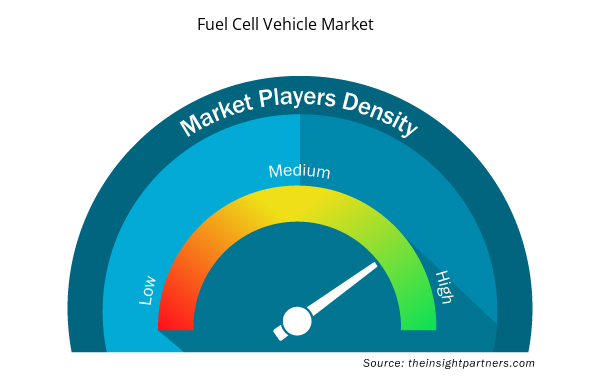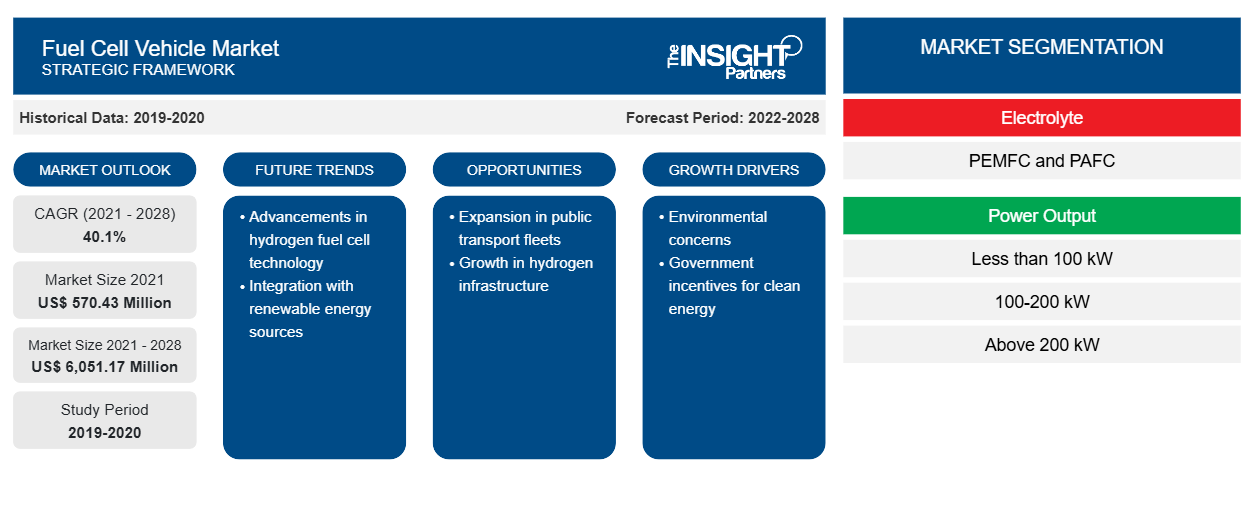[調査レポート] 燃料電池車市場は、2021年の5億7,043万米ドルから2028年には60億5,117万米ドルに達すると予測されており、2021年から2028年の間に40.1%のCAGRを記録すると予測されています。
アナリストの視点:
近年、燃料電池車市場は、従来のガソリン車の有望な代替品として大きな注目を集め、勢いを増しています。燃料電池車(FCV)は、水素と酸素の化学反応によって電気を誘導し、水蒸気のみを排出する水素燃料電池で駆動します。FCVの主な利点の1つは、環境に優しいことです。水蒸気のみを排出するため、温室効果ガスの排出と大気汚染の削減に貢献し、気候変動と都市汚染という世界的な懸念に対処します。この特徴により、燃料電池技術の採用と開発に対する政府の支援とインセンティブが増加しています。市場の成長に関しては、燃料電池車市場は着実な進歩を遂げています。
自動車メーカーやテクノロジー企業は、燃料電池車の効率、性能、手頃な価格を改善するために研究開発に多額の投資を行ってきました。その結果、FCVの航続距離は大幅に伸び、当初の懸念事項の1つであった走行距離の制限が解消されました。燃料電池車市場は、従来の内燃機関や電気自動車に比べるとまだ比較的小規模ですが、今後数年間で大幅な成長が見込まれています。持続可能な輸送ソリューションに対する需要の高まりと、燃料電池技術およびインフラ開発の進歩が相まって、市場の拡大を牽引すると考えられます。さらに、自動車メーカー、エネルギー会社、政府間のパートナーシップとコラボレーションが、燃料電池車市場の成長を促進しています。これらの提携は、燃料電池車の導入を加速し、研究開発を促進することを目的としています。
市場概要:
燃料電池自動車市場は、水素を燃料源として利用して発電する燃料電池技術を搭載した自動車に重点を置いています。環境への懸念の高まりと持続可能な交通手段の必要性により、市場は著しい成長を遂げています。政府の規制とインセンティブは、燃料電池自動車の導入を促進する上で重要な役割を果たしてきました。燃料電池技術の進歩、業界関係者間の協力、継続的な研究開発の取り組みにより、市場の拡大がさらに促進されています。高コストや限られたインフラなどの課題は残っていますが、技術が向上し、よりクリーンな交通ソリューションの需要が高まり続けるにつれて、市場には将来の大きな成長の可能性があります。
要件に合わせてレポートをカスタマイズする
このレポートの一部、国レベルの分析、Excelデータパックなど、あらゆるレポートを無料でカスタマイズできます。また、スタートアップや大学向けのお得なオファーや割引もご利用いただけます。
- このレポートの主要な市場動向を入手してください。この無料サンプルには、市場動向から見積もりや予測に至るまでのデータ分析が含まれます。
市場の推進要因:
環境への関心の高まりが燃料電池車市場の成長を促進
環境への関心の高まりは、燃料電池車の市場成長の重要な原動力として浮上しています。従来のガソリン車が環境に与える悪影響に対する人々の認識が高まるにつれて、よりクリーンで環境に優しい代替交通手段に対する需要が高まっています。この環境意識の高まりにより、燃料電池車にとって好ましい市場環境が生まれています。燃料電池車は、豊富でクリーンなエネルギーキャリアである水素を燃料源として使用します。燃料電池で水素が酸素と混合されると、電気が生成され、副産物として水蒸気のみが残ります。この排出ガスのない動作は、環境意識の高い消費者を引き付ける重要な要素です。大気汚染と温室効果ガス排出に対する意識の高まりにより、政府や規制機関によって環境規制が厳しくなっています。多くの国や地域では、炭素排出量を削減し、持続可能な輸送を促進するための野心的な目標が設定されています。これに応じて、自動車メーカーは、これらの規制を満たし、環境意識の高い顧客層にアピールするために、ポートフォリオの一部として燃料電池車の開発にますます重点を置いています。
さらに、燃料電池技術の進歩により、燃料電池車の性能と効率が大幅に向上しました。これらの車両は、走行距離が長くなり、燃料補給時間が短縮されたため、日常使用にさらに実用的になりました。 水素燃料補給ステーションのインフラの拡大も、燃料電池車の導入に関連する主要な課題の 1 つに対処することで、燃料電池車の市場成長を支えています。さらに、自動車メーカー、エネルギー会社、政府による燃料電池技術への投資と研究努力の増加により、燃料電池車の開発と商業化が加速しています。これらの投資は、燃料電池の技術的能力を向上させただけでなく、生産コストの削減にも貢献し、市場での競争力を高めています。
セグメント分析:
車両タイプに基づいて、燃料電池車市場は乗用車、バス、トラック、および小型商用車に分類されます。乗用車セグメントは2020年に最大の市場シェアを占め、予測期間中に市場で最高のCAGRを記録すると予測されています。乗用車セグメントは、さまざまな要因により、燃料電池車市場で最大のシェアを獲得しました。炭素排出量の削減と持続可能な輸送への移行に対する世界的な関心の高まりにより、燃料電池車の需要が高まっています。自動車メーカーは、燃料電池乗用車の開発と商品化に投資し、効率、航続距離、手頃な価格を改善してきました。
燃料電池乗用車の幅広いモデルが利用可能であること、水素インフラが進歩していること、そして長い走行距離や燃料補給時間の短縮といった燃料電池技術の利点が、このセグメントの成功に貢献しています。全体として、乗用車セグメントは、自動車業界における燃料電池技術の受容と実現可能性の高まりを反映しています。
地域分析:
アジア太平洋地域の燃料電池自動車市場は、2021年に3億169万米ドルと評価され、2028年までに41億1,390万米ドルに達すると予測されています。予測期間中、CAGR 45.2%で成長すると予想されています。アジア太平洋地域は、燃料電池自動車市場の支配的な勢力として浮上しています。この地域は、人口が多く、都市化が急速で、汚染と気候変動に対する懸念が高まっているため、よりクリーンかつ持続可能な輸送手段を積極的に採用しています。この地域の優位性に貢献している主な要因の1つは、燃料電池自動車の導入を促進する政府の強力な支援と政策です。日本、韓国、中国などの国では、燃料電池自動車の使用を奨励するために、有利な規制、税制優遇措置、補助金を実施しています。これらの措置により、メーカー、投資家、消費者のいずれにとっても好ましい環境が整い、市場の成長が促進されています。特に日本は、燃料電池自動車の開発と導入の最前線に立っています。日本政府は、全国に水素ステーションのネットワークを構築することを目指し、水素インフラ整備に関して野心的な目標を設定している。
さらに、トヨタやホンダなどの日本の大手自動車メーカーは、燃料電池車の研究開発に多額の投資を行っており、トヨタ ミライやホンダ クラリティなどのモデルを商品化しています。韓国も燃料電池車市場で目覚ましい進歩を遂げています。政府は水素インフラの開発を優先し、燃料電池バスや商用車の導入を積極的に支援しています。韓国に拠点を置くヒュンダイやキアなどの企業は、ヒュンダイ ネクソやキア ニロなどの革新的なモデルを通じて、燃料電池車の導入を推進する上で重要な役割を果たしてきました。人口が多く、大気汚染への懸念が高まる中国も、燃料電池車の可能性を認識しています。中国政府は、燃料電池車の生産に対する手厚い補助金と目標を導入し、水素技術の世界的リーダーとしての地位を確立しています。BYD、BAIC、Geelyなど、いくつかの中国の自動車メーカーは、燃料電池車の開発に多額の投資を行っており、この地域の市場全体の優位性に貢献しています。さらに、アジア太平洋地域は、その強力な製造能力と技術的専門知識の恩恵を受けています。確立された自動車メーカーの存在と強力なサプライチェーンにより、燃料電池車の生産と商業化が促進されています。さらに、この地域には先進的な研究開発センター、学術機関、産学連携のパートナーシップがあり、燃料電池技術の技術的進歩を促進しています。
主要プレーヤー分析:
燃料電池自動車市場分析には、現代自動車、トヨタ自動車、カミンズ社、ゼネラルモーターズ、ABボルボ、本田技研工業、リバーシンプル、ハイゾンモーターズ、ダイムラーAG、バラードパワーシステムズ社などの企業が含まれています。燃料電池自動車の企業の中では、カミンズ社と現代自動車が、多様な製品ポートフォリオを提供していることから、トップのキー企業となっています。
燃料電池自動車市場の地域別分析
予測期間を通じて燃料電池自動車市場に影響を与える地域的な傾向と要因は、Insight Partners のアナリストによって徹底的に説明されています。このセクションでは、北米、ヨーロッパ、アジア太平洋、中東、アフリカ、南米、中米にわたる燃料電池自動車市場のセグメントと地理についても説明します。

- 燃料電池自動車市場の地域別データを入手
燃料電池自動車市場レポートの範囲
| レポート属性 | 詳細 |
|---|---|
| 2021年の市場規模 | 5億7,043万米ドル |
| 2028年までの市場規模 | 60億5,117万米ドル |
| 世界のCAGR(2021年~2028年) | 40.1% |
| 履歴データ | 2019-2020 |
| 予測期間 | 2022-2028 |
| 対象セグメント | 電解質による
|
| 対象地域と国 | 北米
|
| 市場リーダーと主要企業プロフィール |
|
燃料電池自動車市場のプレーヤー密度:ビジネスダイナミクスへの影響を理解する
燃料電池自動車市場は、消費者の嗜好の変化、技術の進歩、製品の利点に対する認識の高まりなどの要因により、エンドユーザーの需要が高まり、急速に成長しています。需要が高まるにつれて、企業は提供を拡大し、消費者のニーズを満たすために革新し、新たなトレンドを活用し、市場の成長をさらに促進しています。
市場プレーヤー密度とは、特定の市場または業界内で活動している企業または会社の分布を指します。これは、特定の市場スペースに、その規模または総市場価値と比較して、どれだけの競合相手 (市場プレーヤー) が存在するかを示します。
燃料電池自動車市場で事業を展開している主要企業は次のとおりです。
- 現代自動車
- トヨタ自動車株式会社
- カミンズ社
- ゼネラルモーターズ
- ABボルボ
免責事項:上記の企業は、特定の順序でランク付けされていません。

- 燃料電池自動車市場のトップキープレーヤーの概要を入手
最近の動向:
燃料電池自動車市場の企業では、合併や買収などの無機的および有機的な戦略が広く採用されています。最近の主要な市場動向をいくつか以下に示します。
- 2021年4月、SAFRA Materiel Transport PublicとSymbio(ミシュランとフォルシアの子会社)は、水素バス1500台を製造する契約を締結しました。
- トヨタは2020年12月、新型車「ミライ」を発売した。この車は水素を燃料とする燃料電池で動く。トヨタミライには142.2リットルの燃料タンクがあり、燃料電池は最高出力171馬力、最大トルク221Nmを発揮する。
- 過去2年間の分析、基準年、CAGRによる予測(7年間)
- PEST分析とSWOT分析
- 市場規模価値/数量 - 世界、地域、国
- 業界と競争環境
- Excel データセット



Report Coverage
Revenue forecast, Company Analysis, Industry landscape, Growth factors, and Trends

Segment Covered
This text is related
to segments covered.

Regional Scope
North America, Europe, Asia Pacific, Middle East & Africa, South & Central America

Country Scope
This text is related
to country scope.
よくある質問
Hyundai Motor Company, Toyota Motor Corporation, Ballard Power Systems Inc, Hyzon Motors, and Daimler AG are among the leading players offering innovative solution in the market .
Increasing Demand for Clean Energy
Declining Cost of Green Hydrogen
The forecast period for the global fuel cell vehicles market is 2021 to 2028.
The fuel cell vehicle market is expected to witness steady growth during the forecast period from 2021 to 2028, owing to the rising demand from passenger car segment.
APAC is likely to register for the highest CAGR in the fuel cell vehicles market during the forecast period.
The region includes major nations such as India, China, Japan, South Korea, and Australia. South Korea and China are the fastest-growing manufacturing markets in APAC.
Adoption of heavy duty trucks has increased considerably in the recent years. For instance, China witnessed a rise in the registrations of electric vehicles in 2020 by 10% in comparison to 2019. Further, the new registrations for heavy duty vehicles increased by 23% in Europe. Companies operating in the global truck market are working progressively towards the adoption of fuel cell trucks due to longer range the trucks offer. Companies operating in the fuel cell vehicles market have taken up numerous initiatives to boost the adoption of fuel cell trucks in the global market. For Instance, in January 2022, H2 Mobility announced that it aims at deploying 2,000 fuel cell powered trucks on the European roads by 2030.
Based on electrolyte type, the fuel cell vehicles market is segmented into PEMFC and PAFC. The PEMFC segment led the fuel cell vehicles market with a share of more than 99% in 2020
Trends and growth analysis reports related to Automotive and Transportation : READ MORE..
The List of Companies - Fuel Cell Vehicles Market
- Hyundai Motor Company
- Toyota Motor Corporation
- Cummins Inc
- General Motors
- AB Volvo
- Honda Motors Co., Ltd.
- Riversimple
- Hyzon Motors
- Daimler AG
- Ballard Power Systems Inc
The Insight Partners performs research in 4 major stages: Data Collection & Secondary Research, Primary Research, Data Analysis and Data Triangulation & Final Review.
- Data Collection and Secondary Research:
As a market research and consulting firm operating from a decade, we have published and advised several client across the globe. First step for any study will start with an assessment of currently available data and insights from existing reports. Further, historical and current market information is collected from Investor Presentations, Annual Reports, SEC Filings, etc., and other information related to company’s performance and market positioning are gathered from Paid Databases (Factiva, Hoovers, and Reuters) and various other publications available in public domain.
Several associations trade associates, technical forums, institutes, societies and organization are accessed to gain technical as well as market related insights through their publications such as research papers, blogs and press releases related to the studies are referred to get cues about the market. Further, white papers, journals, magazines, and other news articles published in last 3 years are scrutinized and analyzed to understand the current market trends.
- Primary Research:
The primarily interview analysis comprise of data obtained from industry participants interview and answers to survey questions gathered by in-house primary team.
For primary research, interviews are conducted with industry experts/CEOs/Marketing Managers/VPs/Subject Matter Experts from both demand and supply side to get a 360-degree view of the market. The primary team conducts several interviews based on the complexity of the markets to understand the various market trends and dynamics which makes research more credible and precise.
A typical research interview fulfils the following functions:
- Provides first-hand information on the market size, market trends, growth trends, competitive landscape, and outlook
- Validates and strengthens in-house secondary research findings
- Develops the analysis team’s expertise and market understanding
Primary research involves email interactions and telephone interviews for each market, category, segment, and sub-segment across geographies. The participants who typically take part in such a process include, but are not limited to:
- Industry participants: VPs, business development managers, market intelligence managers and national sales managers
- Outside experts: Valuation experts, research analysts and key opinion leaders specializing in the electronics and semiconductor industry.
Below is the breakup of our primary respondents by company, designation, and region:

Once we receive the confirmation from primary research sources or primary respondents, we finalize the base year market estimation and forecast the data as per the macroeconomic and microeconomic factors assessed during data collection.
- Data Analysis:
Once data is validated through both secondary as well as primary respondents, we finalize the market estimations by hypothesis formulation and factor analysis at regional and country level.
- Macro-Economic Factor Analysis:
We analyse macroeconomic indicators such the gross domestic product (GDP), increase in the demand for goods and services across industries, technological advancement, regional economic growth, governmental policies, the influence of COVID-19, PEST analysis, and other aspects. This analysis aids in setting benchmarks for various nations/regions and approximating market splits. Additionally, the general trend of the aforementioned components aid in determining the market's development possibilities.
- Country Level Data:
Various factors that are especially aligned to the country are taken into account to determine the market size for a certain area and country, including the presence of vendors, such as headquarters and offices, the country's GDP, demand patterns, and industry growth. To comprehend the market dynamics for the nation, a number of growth variables, inhibitors, application areas, and current market trends are researched. The aforementioned elements aid in determining the country's overall market's growth potential.
- Company Profile:
The “Table of Contents” is formulated by listing and analyzing more than 25 - 30 companies operating in the market ecosystem across geographies. However, we profile only 10 companies as a standard practice in our syndicate reports. These 10 companies comprise leading, emerging, and regional players. Nonetheless, our analysis is not restricted to the 10 listed companies, we also analyze other companies present in the market to develop a holistic view and understand the prevailing trends. The “Company Profiles” section in the report covers key facts, business description, products & services, financial information, SWOT analysis, and key developments. The financial information presented is extracted from the annual reports and official documents of the publicly listed companies. Upon collecting the information for the sections of respective companies, we verify them via various primary sources and then compile the data in respective company profiles. The company level information helps us in deriving the base number as well as in forecasting the market size.
- Developing Base Number:
Aggregation of sales statistics (2020-2022) and macro-economic factor, and other secondary and primary research insights are utilized to arrive at base number and related market shares for 2022. The data gaps are identified in this step and relevant market data is analyzed, collected from paid primary interviews or databases. On finalizing the base year market size, forecasts are developed on the basis of macro-economic, industry and market growth factors and company level analysis.
- Data Triangulation and Final Review:
The market findings and base year market size calculations are validated from supply as well as demand side. Demand side validations are based on macro-economic factor analysis and benchmarks for respective regions and countries. In case of supply side validations, revenues of major companies are estimated (in case not available) based on industry benchmark, approximate number of employees, product portfolio, and primary interviews revenues are gathered. Further revenue from target product/service segment is assessed to avoid overshooting of market statistics. In case of heavy deviations between supply and demand side values, all thes steps are repeated to achieve synchronization.
We follow an iterative model, wherein we share our research findings with Subject Matter Experts (SME’s) and Key Opinion Leaders (KOLs) until consensus view of the market is not formulated – this model negates any drastic deviation in the opinions of experts. Only validated and universally acceptable research findings are quoted in our reports.
We have important check points that we use to validate our research findings – which we call – data triangulation, where we validate the information, we generate from secondary sources with primary interviews and then we re-validate with our internal data bases and Subject matter experts. This comprehensive model enables us to deliver high quality, reliable data in shortest possible time.


 このレポートの無料サンプルを入手する
このレポートの無料サンプルを入手する